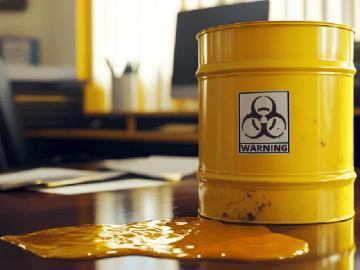A company’s culture is the heartbeat of its organization. It shapes how employees interact, handle problems, and achieve goals. But just like anything else, culture can run off course.
A toxic work culture can develop quietly, slowly eroding morale, creativity, and productivity. Over time, it creates barriers that prevent the company from reaching its full potential.
In this article, we'll explore what makes a culture toxic, how it impacts success, and why addressing a toxic culture is crucial for the long-term health of your organization.
15% of respondents labeled their workplace as somewhat or very toxic. (APA’s 2024 Work in America survey)
What is a Toxic Work Culture?
Generally speaking, a toxic workplace is one where negativity is deeply embedded in the culture, significantly hindering productivity and performance. Such environments are characterized by several detrimental features:
Excessive Workloads
Often, employees are burdened with workloads that exceed reasonable limits.
Absence of Clear Boundaries
The lack of well-defined boundaries between professional and personal life can cause employees to feel perpetually on call.
Exclusivity and Cliquishness
A non-inclusive culture can alienate employees, creating an environment where only certain individuals or groups are valued.
Limited Opportunities for Growth
Toxic organizations often fail to provide avenues for professional development, leading employees to feel stagnant and undervalued.
Lack of Transparency
When organizations withhold information or make decisions without clear communication, it breeds employee mistrust and uncertainty.
Micromanagement
Excessive oversight and control over employees' work can stifle creativity and autonomy.
Fear-Based Leadership
When higher-ups adopt an authoritarian or punitive approach, employees may feel powerless and compelled to conceal mistakes to evade potential backlash.
Impacts of Toxic Workplace Culture
A toxic workplace culture can have profound effects on both organizational performance and employee well-being. While each organization is unique, certain common impacts are almost guaranteed to occur in a toxic environment:
Performance and Productivity
High Turnover Rates
Toxic cultures often lead to elevated attrition rates, as employees seek healthier work environments. This constant turnover disrupts team cohesion and incurs significant recruitment and training costs.
Disengaged Employees
When employees feel undervalued or unsupported, their engagement levels drop, resulting in decreased productivity and a lack of initiative. Engaged employees are more likely to go above and beyond, driving organizational success.
Silent Quitting
In toxic workplaces, employees may reduce their efforts to the bare minimum, disengaging from tasks and responsibilities. This phenomenon, known as quiet quitting, can significantly slow progress and hinder overall performance.
Employee Health and Well-being
Stress
A toxic culture often fosters an environment of constant pressure and unrealistic expectations, leading to chronic stress among employees. This persistent stress can have detrimental effects on both mental and physical health.
Mental Health Issues
Exposure to a toxic workplace can contribute to anxiety and depression, as employees struggle to cope with negative interactions and a lack of support. These mental health challenges can further impact job performance and satisfaction.
Burnout
Continuous exposure to a toxic culture can lead to burnout, characterized by emotional exhaustion, reduced performance, and a sense of detachment from work. Burnout not only affects individual employees but also the organization's overall productivity.
Physical Health Issues
The stress and mental health challenges associated with a toxic workplace can manifest in physical health problems, including headaches, sleep disturbances, and cardiovascular issues. These health concerns can lead to increased absenteeism and decreased productivity.
Recognizing these signs is crucial, as they directly impact an organization's success. Creating a positive culture and preventing a toxic environment are essential, as employees' productivity, health, and well-being are integral to success and affect every level of the organization.
Why Improving Culture is Important
Beyond the immediate negative impacts of a toxic culture as mentioned above, there are several compelling reasons to prioritize cultural improvement:
Escalating Healthcare Expenses
Employers who provide healthcare benefits may face increased costs due to higher medical claims from employees affected by a toxic work environment.
Challenges in Talent Acquisition
Prospective employees often research company cultures through platforms like Glassdoor. A reputation for a toxic workplace can deter top talent, making it more difficult to attract and retain skilled professionals. This can result in prolonged vacancies and increased recruitment costs.
High Employee Replacement Costs
Replacing an employee who leaves due to a toxic culture can be costly. According to Gallup, the expense of replacing an individual employee can range from one-half to two times the employee's annual salary.
So, there you have it. Addressing and transforming a toxic workplace culture is not merely a managerial task but a strategic imperative. By proactively identifying and rectifying the elements that foster negativity, organizations can unlock their full potential, leading to enhanced performance, improved employee well-being, and a more robust bottom line.
References
- https://www.apa.org/topics/healthy-workplaces/toxic-workplace
- https://hbr.org/2024/01/how-to-tell-if-a-prospective-workplace-is-toxic
- https://sloanreview.mit.edu/article/how-to-fix-a-toxic-culture/
- https://sloanreview.mit.edu/article/why-every-leader-needs-to-worry-about-toxic-culture/
- https://newsroom.haas.berkeley.edu/research/how-narcissistic-leaders-infect-their-organizations-culture/
- https://haas.berkeley.edu/faculty-spotlight/when-me-trumps-we-berkeley-haas-expert-shows-how-narcissistic-leaders-infect-their-organizations-cultures/
- https://college.emory.edu/faculty/documents/articles/leadingwithculture…
%20_Culture%20as%20a%20Leadership%20Tool.pdf - https://236328.fs1.hubspotusercontent-na1.net/hubfs/236328/Lead%20Gen%20Content/PDFs%20for%20Download/LHPC%20Infographic%20week%202_Culture%20to%20Promote%20Innovation.pdf
- https://236328.fs1.hubspotusercontent-na1.net/hubfs/236328/Lead%20Gen%20Content/PDFs%20for%20Download/LHPC%20Infographic%20week%203_Develop%2c%20Manage%2c%20and%20Change%20Culture.pdf
- https://236328.fs1.hubspotusercontent-na1.net/hubfs/236328/Lead%20Gen%20Content/PDFs%20for%20Download/LHPC%20Infographic%20week%204_Leaders%20Guide%20to%20Culture.pdf
- Cultures of Genius at Work: Organizational Mindsets Predict Cultural Norms, Trust, and Commitment - research by Jennifer Chatman
- Behavioral Norms, Not Personality, is How Cultures Change
- https://sloanreview.mit.edu/article/toxic-culture-is-driving-the-great-resignation/
- https://www.hhs.gov/surgeongeneral/priorities/workplace-well-being/index.html
- https://www.betterup.com/blog/what-is-company-culture
- https://www.gallup.com/workplace/509069/diagnosing-broken-culture.aspx
Dive Deeper
Take a deep-dive into this topic and gain expert, working knowledge by joining us for the program that inspired it!
Leading Strategy Execution through Culture Program
Learn how to manage change and innovation in your company while implementing a business culture that drives strategic goals.
Learn moreThe Berkeley Transformative CHRO Leadership Program co-led by Laszlo Bock
Transform your HR leadership skills through Laszlo Bock's real-world experience and cutting-edge research from renowned Berkeley faculty.
Learn moreThe Berkeley Executive Leadership Program
Advance your leadership qualities, build skills to strategically address business challenges head-on, and apply strategic decision-making.
Learn more


